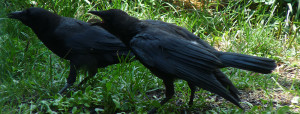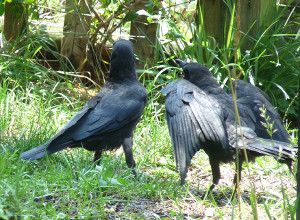The American crow (Corvus brachyrhynchos) is a large, loud and obvious avian species that inhabits a wide variety of habitats throughout Western Pennsylvania. They were recently featured on the cover of the March/April 2016 issue of Audubon magazine (the bird equivalent, I am sure, of a musician being on the cover of Rolling Stone!). The articles in this issue focused on a number of studies that evaluated the intelligence and individual and communal memories of crows.
For example, John Marzluff at the University of Washington in Seattle went out in the 1990’s and caught and banded (and then released) a cohort of crows. Marzluff and his banding team wore “caveman” masks while they were netting and banding the crows. Subsequently, Marzluff and his team returned to the crow banding area and were ignored unless they wore their caveman masks (even Dick Cheney masks did not elicit a violent crow response!). Not only did the crows that had been directly captured and handled by the caveman scientists remember and react to the caveman masks, but also their fellow flock (or “murder” as a crow flock is called) members quickly learned the caveman face and joined in on the mobbing and commotion. Marluff’s team regularly returns to this crow territory and, although it has been over ten years since the initial trapping event and the originally trapped crows are now undoubtedly all dead and gone, the flock still responds in what the article labels a “crowpocalyspe” whenever the caveman masked researchers return.
These studies (along with some remarkable brain activity analyses using PET scanners and radioactive isotopes) not only show the individual crow to be extremely intelligent (Mazluff calls them “flying monkeys!”) but also highly connected within its flock to a communication and information system that has to be defined as a culture!
Crows are seldom seen alone. In the non-breeding part of the year (fall through the winter) they form large, communal flocks of hundreds to thousands of individuals. Increasingly these large, winter flocks can be found in urban areas (much to the distress of the area’s human residents!). Lancaster, PA, for example, had 20,000 overwintering crows in its Park City Mall a few years ago, and a number of towns in Pennsylvania have faced the loud (and messy) problem of large flocks of winter roosting, “urban” crows! The warmth and lights of the city environment and the protection it brings from great horned owls and other crow predators are thought to be some of the factors that are selecting for these urban-centered crows. During the breeding season (spring to late summer) crows form smaller, more cohesive, familial flocks, that break up into even smaller foraging groups that daily travel out across the countryside looking for food.
Communication between individuals in the foraging groups and within the larger flocks is a very important aspect of crow biology. The remarkable and extensively documented intelligence of crows (their ability to solve food-gathering problems, to learn to mimic human vocalizations, to employ a variety of complex strategies to gather food etc.) is thought to be a direct extension of their evolutionary success as a social, highly efficiently communicating species. Crows, by the way, have longer rearing and nurturing periods than other bird species. These “learning periods” are even longer than those observed in many mammals! These nurturing periods can last up to a year and a half and enable the parental generation to communicate extensive amounts of very functional survival information (hunting and foraging strategies and techniques, habitat selection preferences, etc.) to their offspring.
American crows can be found residing in or moving through a great variety of ecological habitats. They seem to prefer a broad functional range that includes both fields (for grasses and seeds and for small vertebrate and invertebrate prey species) and woodlands (for night roosts and for protection). Human agricultural systems are especially favored by the American crow. Their negative impacts on grain crops can be extensive. It is estimated that in the United States the American crow population numbers over three billion individuals! Many states (including Pennsylvania) allow hunting of crows to try to control their numbers.
Crows eat a great variety of foods. Invertebrates (like grasshoppers, grubs, earthworms, and caterpillars) are consumed as they become seasonally abundant. Vertebrates (bird eggs, small birds, rodents) are eaten opportunistically or may even be actively hunted. One spring, a few years ago, out in my side field, I observed a crow swooping down on a low flying female northern cardinal. The crow slammed down on the cardinal striking it with its chest and knocking it to the ground. The crow then landed next to the dazed, but still moving cardinal, picked it up in its beak, and flew off with it. Several other crows followed close behind, and the whole group was loudly pursued by five or six blue jays. I have in the past also observed crows picking off young red squirrels as they walked in line along a tree branch behind their parent.
Crows also eat carrion and are active scavengers of human garbage. Crows utilize their excellent vision to find and obtain their food. While hunting and feeding individuals of the flock take on specialized jobs (some functioning as lookouts, for example, while other members of the flock feed). Vocal communications between individuals of the flocks are critical to the overall success of the foraging group. Complex hunting behaviors have also been observed in crows. Some these include mobs of crows driving rabbits from a field across a roadway. A few of the driven rabbits were hit by cars and were then eaten by the crows. Crows have also been observed actively interfering with other predators (like river otters) to distract them from their captured prey which the crows then appropriate for their own consumption. These behaviors are further examples of the group dynamics and extreme intelligence of this remarkable species.
I have written before about “my” crows. There are three crows that wait for me each morning to come out and dump a couple of handfuls of peanuts under my bird feeders. They watch me from surrounding tree tops, excitedly caw when I carry out my bucket of birdseed, corn and peanuts to fill my feeders, and often swoop down to start picking up and swallowing as many peanuts as they can (as fast as they can) even before I get back to my front porch.
Crow populations have been increasing all around the world. Some researchers speculate that this incredibly adaptable and intelligent species is benefiting from the ongoing population declines in most of the more specialized avian species. The adaptable, generalist crow can occupy many niches in an ecosystem. We will undoubtedly be seeing a lot more of them in the coming years!





Am just catching up on my “Signs of…” reading. Loved hearing about “your” crows. They sound like an enthusiastic and well-fed bunch! The news about crow populations increasing put me in mind of Ian Frasier’s humorous essay “Count on Crows,” which I think I first read in Harper’s. The crows hire him to correct public misperceptions about them. It’s a great read (and judging from crow intelligence, maybe not too far off the mark!).